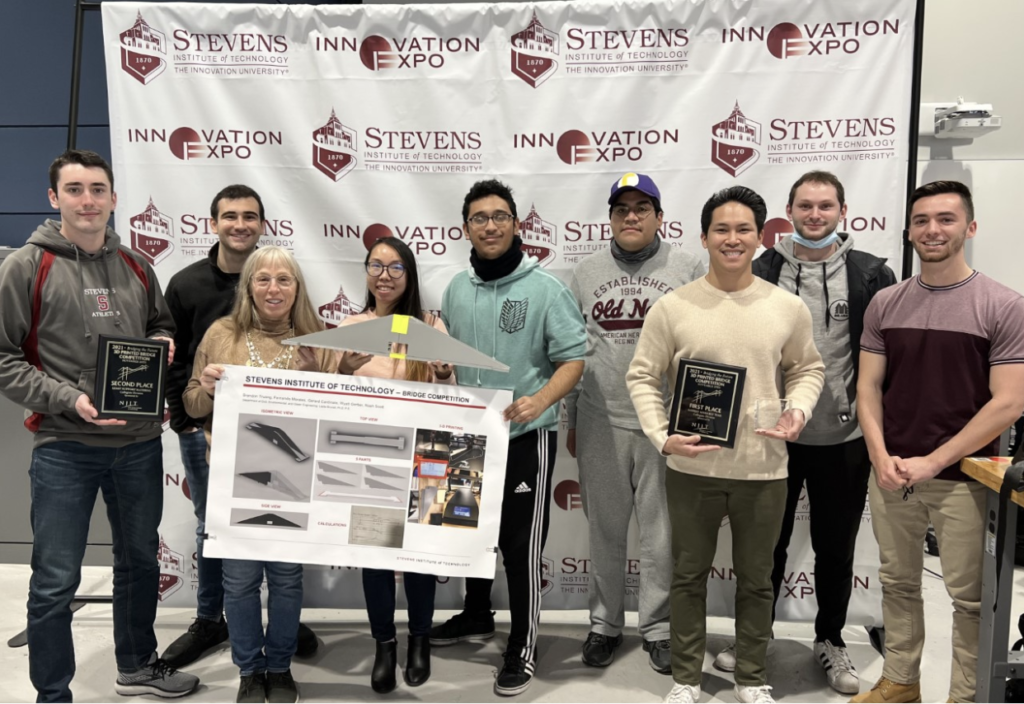Last November, a group of civil engineering students from Stevens participated in the inaugural NJIT 3D Printed Bridge Competition. High schools and universities alike from the New Jersey area were invited to participate by printing and assembling a bridge that was then tested for the amount of vertical load it could withstand. The team won second place overall in the competition and brought back a $500 3D printer as a prize.

For the competition, teams were given constraints as to the dimensions of their bridge—namely, the dimensions it was required to fit within, and the dimensions of the space they had to clear with their bridge. The bridge was also not allowed to have any adhesive or non-mechanical connections.
“With that set of rules, we sat down together to come up with multiple conceptual prototypes of designs that we wanted, and it came down to two or three designs that we really liked,” said Brandon Truoung. Truoung, a 5/5 Civil Engineering student attending Stevens, led the team in designing, prototyping, and finalizing the bridge that they used in the competition. “We used a couple of software such as Fusion360 to model our bridge and sent that over to the Proof Lab in Gateway South.”
The competition follows the growing trend of 3D printing in everyday applications. 3D printed material has been explored as a solution for building cheap, eco-friendly houses, and lightweight, easy-to-assemble bridges—qualities the competition emphasized as well. Aside from vertical load, which was measured by adding 20 lb increments to a hanger attached to the middle of the bridge, the competition judged bridges in Least Support Material, Fastest Assembly Time, Stiffest Bridge, Best Aesthetics, and Best Presentation. Facing these categories, the Stevens team decided to focus on simplicity in design and ease of printing, which won them first place in fastest assembly time and second place in least support material.
“The bridge consisted of four triangles oriented back to back above the bridge deck,” explained student Gerard Cardinale, one of the team’s designers. “This placement targeted the center of the bridge, which the team understood to be the weakest section due to the maximum bending moment occurring at this location.”
Truoung expressed that analyses were also made “calculating the shear and moment forces that would go into the bridge and predicting where at which point it would fail,” which the team was able to predict successfully. Truoung and Cardinale both agreed that their prior experience in and out of classes at Stevens proved to be useful in the competition.
“The core curriculum that we’ve taken as [engineering] undergrads definitely helped us a lot in this competition […] I would say about 70% of the [knowledge we needed] was already taught, and we already had experience with it from the core curriculum, while the other 30% was just knowledge that we’ve gained from our internships,” said Truoung.
Bridge-building isn’t only confined to the work industry. Truoung recalls building truss bridges out of balsa wood in high school, and points to the Design 3 and Design 6 classes at Stevens as particularly hands-on classes where bridges were modeled and analysed with Midas Civil, a Finite Element Analysis software. Cardinale also recalled his Structural Analysis and Structural Steel Design classes being especially useful during the design phase of the competition.
Overall, what had started out as technology used only for rapid prototyping has turned into a source of production for many industries, and it can only be expected to expand from here.
The Stevens team was extremely grateful for the opportunity to compete. Truoung said, “A large portion of the team will be going into structural engineering […] This is definitely what they’ll be doing in their fields. The bridge competition gave us the opportunity to apply the skills we learned in school and in our internships, and it helped us prepare us for the future as well in our careers beyond Stevens. Additionally, it was a really good feeling being able to represent our school in front of the ASCE board members and judges. We had a lot of pride, taking home all the hardware that we earned [for the school.”
Be First to Comment